Over 1.106.000 registered users (EN+CZ).
AutoCAD tips, Inventor tips, Revit tips, Civil tips, Fusion tips.
Try the new precise Engineering calculator.
New AutoCAD 2026 commands and sys.variables and env.variables,.
 Discussion forum
Discussion forum
?CAD discussions, advices, exchange of experience
 CAD discussion forum - ask any CAD-related questions here, share your CAD knowledge on AutoCAD, Inventor, Revit and other Autodesk software with your peers from all over the world. To start a new topic, choose an appropriate forum.
CAD discussion forum - ask any CAD-related questions here, share your CAD knowledge on AutoCAD, Inventor, Revit and other Autodesk software with your peers from all over the world. To start a new topic, choose an appropriate forum.
Please abide by the rules of this forum.
This is a peer-to-peer forum. The forum doesn't replace the official direct technical support provided by ARKANCE for its customers.
How to post questions: register or login, go to the specific forum and click the NEW TOPIC button.
|
Post Reply 
|
| Author | |
LTunlimited RSS 
RSS robots 
Joined: 23.Nov.2009 Status: Offline Points: 368 |
 Topic: Heigh ho, heigh ho, it's back to work we go... Topic: Heigh ho, heigh ho, it's back to work we go...Posted: 04.Jan.2010 at 10:07 |
|
Autodesk (including me, of course) is back to work today after our two-week holiday break. It was nice to have the time off, but now it's time to dive right in again.I thought I'd start the new year off easy, though, with a tip about the different color, linetype, and lineweight options in AutoCAD LT: BYBLOCK, BYLAYER, and "by object".BYLAYER is probably the most common setting, and is definitely the most-recommended setting by CAD Managers. It means that objects inherit the color/linetype/lineweight of the layer they're on. In other words, let's say you have a layer called WALL whose color is set to green. Any object on the WALL layer whose color is BYLAYER will be green. If you change the color of WALL to blue (through the Layer Properties Manager), all those BYLAYER objects will also become blue."By object" is another option, although that's not an official term -- all it means is that the object has a color/linetype/lineweight that is neither BYLAYER nor BYBLOCK. Objects set this way do not update when their layer settings change. (That's why CAD Managers don't like it.) Going back to our WALL example, if you have an object whose color is set to red, it doesn't matter what the WALL layer color is -- that object will always stay red.(I'd post a sample image for you, but I'm pretty sure you all are smart enough to figure these out yourselves.)BYBLOCK is the last option. It only applies to objects inside dimensions or block definitions. BYBLOCK enables these objects to inherit the individual properties of the host object or dimension. Let's say we have a block called DOOR on our WALL layer. (I know, I know, bad practice, doors should have their own layer -- just roll with it for now.) All the objects that make up the DOOR block are set to BYBLOCK.Remember, the WALL layer is blue. If the color of the DOOR block is set to BYLAYER, then it appears blue, just like the WALL layer. But if you apply a color override, the entire block changes color. If the objects inside the block were set to BYLAYER, you can apply a color override to the block and it won't change color. That's because the objects are still inheriting the layer properties, not the block properties.The other thing to know is that the objects are inheriting the WALL layer properties because they were created on Layer 0. Objects in a block created on any other layer follow the properties of those layers -- not the properties of the host layer.You can also apply properties overrides to the block objects themselves. That way, they stay permanently the way they were, regardless of the layer or block color. In the last example, the block objects were set to green inside the block definition. Â
Go to the original post... |
|
|
LT Unlimited - Autodesk blog by Kate Morrical
|
|
 |
|
Post Reply 
|
|
|
Tweet
|
| Forum Jump | Forum Permissions  You cannot post new topics in this forum You cannot reply to topics in this forum You cannot delete your posts in this forum You cannot edit your posts in this forum You cannot create polls in this forum You cannot vote in polls in this forum |
This page was generated in 0,195 seconds.
![CAD Forum - tips, tricks, discussion and utilities for AutoCAD, Inventor, Revit and other Autodesk products [www.cadforum.cz] CAD Forum - tips, tricks, discussion and utilities for AutoCAD, Inventor, Revit and other Autodesk products [www.cadforum.cz]](/common/arkance_186.png)









 Heigh ho, heigh ho, it's back to work we go...
Heigh ho, heigh ho, it's back to work we go... Topic Options
Topic Options


